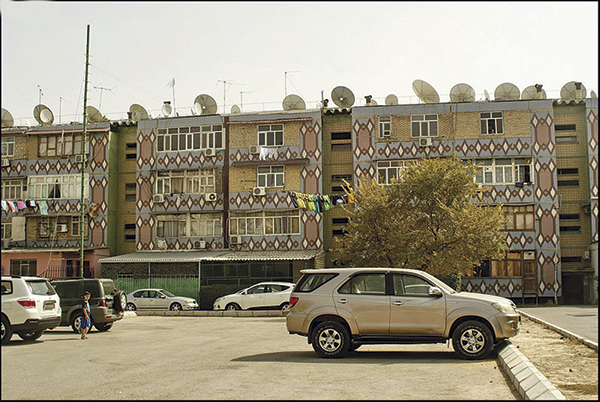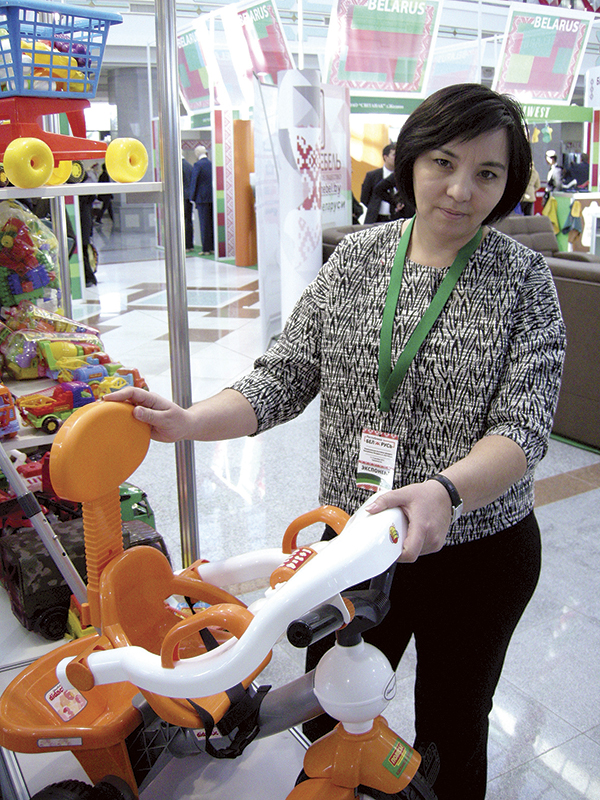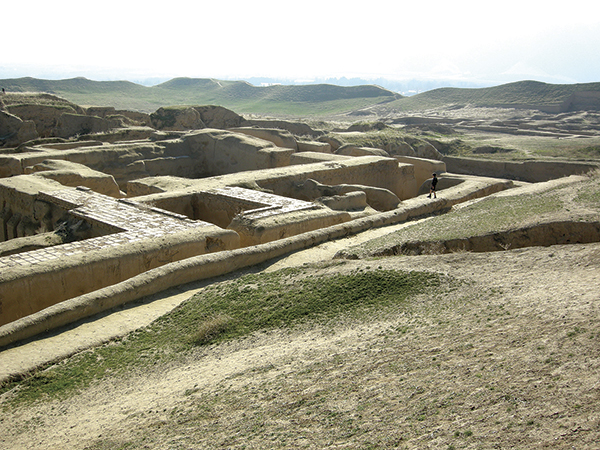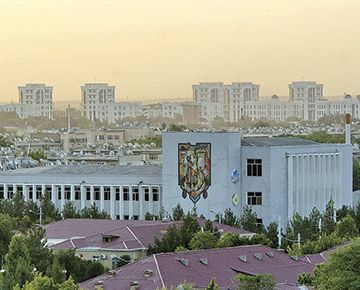Maybe those who survived the devastating earthquakes of 5th and 6th October 1948, soon after the war, realised the vulnerability of our human state? Perhaps surviving one of the most devastating earthquakes in the history of humankind showed them the importance of humanity and charity, of commitment to doing only good?
Survivors of that tragedy have worked to heal their wounds with soothing words and kind gestures. Sometimes, silence is enough. Ashgabat citizens still remember the catastrophe, which killed dozens of thousands and injured so many more. St. Petersburg survivors of the Siege share some elements of the same bittersweet pain. Belarus, the land of partisans, lost every third citizen in the war, so we well know how the soul grows on surviving torment.

Aqsaqal. At the bus stop in Ashgabat

Local Turkmen boy runs into his tomorrow over the ramparts of ancient Nisa (the IIIrd century B.C.). December 2015
Olga and Allanur
People are the most interesting element of any nation, rather than architecture, monuments or memorials. Looking through our notepads and listening to interview recordings, we recollect some amazing meetings. We’ll start by telling you about a couple from Ashgabat, who gave us a tour of the old city, from no other motive than the desire to show us a warm welcome. We were strangers, yet they drove us to Nisa, the historical and cultural reserve near Ashgabat, one of Turkmenistan’s three sites listed among UNESCO’s Treasures of Cultural Heritage.
We met Allanur Shikhdurdyev (whose first name can be translated as ‘Heavenly Light’) and Olga Solovieva at a book fair, one sunny morning in December. Their daughter was at school, and the couple, in their early 30s, were browsing books, magazines and leaflets on our Information Ministry stand. We began chatting and it was clear that they were interested in learning more about Belarus. Maybe, because Olga is of Russian and Turkmen origin, coming from an officer’s family. Living in the East, she’s interested in learning more about the Slavic people.

Olga and Allanur against the background of Ashgabat Circus building
We read on the Internet that the number of Russians living in Turkmenistan is now eight times less, having reduced from 340,000 in the Soviet times. Like Belarusians, they have left the country or have sent their children and grandchildren to study at Russian-language universities, as not all speak Turkmen fluently. All the country’s higher education establishments teach in Turkmen. Meanwhile, high-ranking posts tend to be occupied by those of Turkmen ethnicity. Olga communicates with her Russian relatives online and tells me that her classmate studied in Minsk, and liked living in Belarus.
Allanur is also a ‘child of many nations’, having Uzbek and Jewish blood. His intelligent grandmother, born in Odessa, escaped to Turkmenistan from the war. His grandfather’s kin were highly cultured and educated, his grandfather studying at a madrasah in Khwarezm (the ancient cultural oasis in the northwestern part of Uzbekistan). Becoming a priest, his grandfather lived a long and interesting life and died at the age of 100.
Allanur, born in Ashgabat, studied to be a teacher of languages and philology, and worked at a school for some time. However, he switched to gas extraction in search of a higher salary (even prior to the crisis in which Russian incomes fell, minimum wages in Turkmenistan were 10 percent higher than those in Russia). Allanur’s breeding shows itself in his delicate wit, and thoughtful judgements, his neatly arranged Russian phrases and his easy shifting from Russian to Turkmen.

There are still such exotic houses in the old districts of Ashgabat
We learnt a new word from them: Nakhalstroy (combining the roots of nakhal meaning ‘jerk’ and stroy meaning ‘build’). It sounds rather oriental. In fact, it’s the name of a city suburb (in Gazha District) where buildings were raised without any documentation. Allanur and Olga have a new 3-room flat that they’ve decorated recently and readily invited us for tea and cakes following our tour. Sadly, we didn’t have time. They note that Turkmen strong family traditions manifest in family groups tending to live in close proximity, within blocks of flats. Some newly-built residential houses even have common use kitchens, convenient for big feasts, showing that old traditions continue to be embraced in the modern city.
Touring old Ashgabat, the 30th micro-district, we saw derelict homes, including in inner suburbs, under tall, shady trees. It was quite an exotic spectacle. In preparing this text, we found a series of photo stories about Ashgabat, featuring comments and shots by a Belarusian blogger. He writes, “Most tourists who stay in the Turkmen capital for a brief while think that Ashgabat is an ultramodern city, with beautiful broad avenues, high white-marble houses, luxurious governmental buildings, countless fountains, monuments and memorials…” Yet, he notes, old Ashgabat is home to 80 percent of the city’s population. You can easily find his blogs by searching for TomkaD. Under the motto ‘using my mind and my hammer’, he graduated from the Geographical Department of the Belarusian State University in 2011 (probably, as a geologist), and now works in Turkmenistan, as do many Belarusian specialists. He’s passionate about travel, his blog featuring about 10,000 photographs, including beautiful ones of Belarus.

During our tour, our guides told us to look attentively, since much of what we were seeing would soon be gone, swept away during coming renovations. The city is to host the 5th Asian Indoor and Martial Arts Games in 2017, so old streets are being broadened, with some green zones removed and old house facades are being covered with white marble. Many of the mosaics on walls, superstructures over apartment entrances, and antennas on top of Khruschev-epoch five-storey blocks are crumbling. Progress is ousting the traditional.
Tower that Survived an Earthquake
Allanur and Olga showed us Ashgabat Circus, and we photographed our new acquaintances standing in front. The building is one of the city’s greatest places of interest. Previously, Ashgabat’s hydro power station stood on the site. It survived the earthquake of October 6th, although there was a blackout across the city. Its four high-capacity engines continued operating, but were in danger of damage. In inky darkness, risking his life, the head of the shift, Nurgeldy Meredov, stopped the first engine and, soon, others came to help. They prevented potential overload, allowing the electrical plant to return power amidst the city ruins.
We made our second stop at the orthogonal clock tower: one of few buildings not destroyed during the 1948 earthquake. It was once part of Ashgabat Textile Factory, recollects Mikhail Goldshtein, one of the witnesses. He tells us, “The factory, although damaged, was not devastated and stood tall in the city ruins. The high tower, with its clock, could be seen from a distance. For many years, it was a symbol of Ashgabat. I remember well the Capitals of the Soviet Socialist Republics stamp series. The Turkmen SSR and its capital, Ashgabat, were represented in the series by an image of this clock tower.”
 |  |
The clock tower at the entrance to the territory of Ashgabat Textile Factory is one of few buildings not destroyed during the 1948 earthquake. The tower has been a symbol of Ashgabat for a long time
Why didn’t the tower fall? It was built shortly before the earthquake, by young engineer Goldin. “I studied at the same school with his daughter, after the men’s and women’s schools were joined,” recalls Mikhail Goldshtein. “Goldin was accused of overuse of cement, and a criminal case was initiated against him. After the earthquake, it became obvious that he had been wrongly accused, since his building stood up to the shocks. Court proceedings were terminated and, soon after, he became one of the most famous constructors, who restored Ashgabat.” The natural catastrophe helped him prove his innocence. Quality construction is the best protection from calamity.
Allanur and Olga tell us that it was Stalin who, following the earthquake, decided that the city should be restored on its former site and that Ashgabat should remain the capital. How many people were killed in the earthquake? Some sources, published fifteen years after the catastrophe, provide figures and conclusions. According to some official statistics, the number of casualties stood at 40,000-60,000 people. Meanwhile, 25,000-30,000 people may have been injured.
The city was almost completely devastated, with between 90 percent and 98 percent of residential, utility, manufacturing, cultural and communal buildings destroyed or knocked out of service. Surviving buildings were in poor shape, and often had to be demolished later. As the city had to be rebuilt urgently, cheap labour was brought from Siberian camps, so that convicts could erect buildings.

Decoration on the wall of the old house
Allanur and Olga’s story is confirmed by Mikhail Goldshtein’s article, which states that convicts helped build the railway station, the prison, the city hospital, Academy of Science buildings, the Medical and Agricultural Institutes, the State University, the Opera and Ballet Theatre, the Russian Theatre (now, A. S. Pushkin State Russian Drama Theatre) and the National Drama Theatre, alongside buildings of the Council of Ministers, the Central Committee of the Party, and various hotels, schools and housing. The architects learnt a bitter lesson. Rather than building with bricks (including air bricks) they used reinforced concrete and wooden structures for smaller buildings.
In the aftermath of the catastrophe, the city saw large-scale construction, but housing remained insufficient for some time. “During the hot summer, it was impossible to stay inside tiny cabins, so many citizens would ‘live’ outdoors,” states Goldshtein. “They placed tables, benches and beds in the shade of trees and would cook on kerosene stoves, eating and sleeping there. In the evening, they’d water and sweep their courtyard, then gather to chat and relieve their hearts in the chill of the night. This is how the Ashgabat lifestyle emerged: trusting, sympathetic and humane. This facilitated an open, friendly attitude. When I accompanied my mother to the market, I was astonished at how many people in the street would greet her.”
All this brings to mind the famous lines by Vladimir Mayakovsky:
You leave the land with air as sweet as a fruit drink
To travel around the world
Yet, you can’t fall out of love
With the land where you’d be frozen old
All who visit the troubled city may remember its special atmosphere. The capital, understandably, translates its ‘living standards’ across the country, and visitors feel it, too. Among them are Belarusian people. Journalist and writer Ales Karlyukevich fell in love with Turkmenistan back in the 1980s, when he served in the Army. Now he is chronicling the history of Belarusian-Turkmen cultural relations.

View to old Ashgabat from the hotel window
Viktor Yudenok, from the village of Savichi, in Bragin District of Gomel Region, has taken a strong liking to hot Ashgabat. After graduating from Vitebsk Medical Institute in 1972, as a pharmacist, he was assigned a job in Turkmenistan. He stayed on, and now lives in Ashgabat, occupying a high post at the Ministry of Health. He regularly visits his father, Savely Krivulko, who lives in Belarus, in the village of Sharibovka, in Buda Koshelevo District.
Business is not a Toy, yet Toys are Business
It’s a known fact that Belarus has friendly and business relations with this Central Asian state. In the early 21st century, Turkmenistan was removed from the UN Least Developed Countries List, and many countries now wish to establish friendly relations. In particular, Allanur tells us that South Korean companies are implementing large contracts for gas extraction and processing. He adds, “Turkey is carrying out major construction projects, the French are building some elite sites, the Japanese are re-equipping gas chemical plants, and the Germans are developing mid-sized businesses. Turkmen currency is printed by the British and the Italians are purchasing our cotton.”
Turkmenistan has huge potential for development, ranking fourth globally for proven natural gas reserves, and the Turkmenistan-Afghanistan-Pakistan-India (TAPI) pipeline is being built.
Belarusian industrial enterprises have shown particular interest in the Turkmen economy, as we’ve written previously. This time, we wanted to talk to those promoting Belarusian goods to the Turkmen market. At the fair, we noticed some lovely Belarusian toys, made from plastic and fabric. Margarita Aksenova, a private entrepreneur, has been supplying the toys.

Margarita Aksenova, a private entrepreneur, sells Belarusian children toys in Ashgabat
Margarita’s parents settled in Ashgabat in the Soviet times, so she is almost ‘native’. Her daughter starts school this year. “About three years ago, we participated in the CIS member states fair,” she recalls. “There were various goods manufactured by various companies and we noticed lovely toys from Belarus. Your soft toys, in particular, were attractive, and I liked a realistic toy Collie dog, made by a Malvina firm. I was running a small company, and approached the Belarusians. We’ve been cooperating ever since,” says Margarita.
Her company has now expanded, and is also liaising with a Polesie company from Kobrin, which makes wonderful toys. In Brest on business, where she was meeting with another famous company she works with, Gefest, she visited nearby Kobrin. She notes, “The people running this toy-producing factory are adorable! Initially, there were just four of them, making toys in a garage. Now that their business has grown, they have modern production facilities, including lovely assembly workshops; it’s fantastic! I admire their quality control procedures and they are very decent people. Dealing with them is a pleasure.”
Three years ago, in May, the first container arrived from Belarus, bringing toys to Ashgabat shops across the city. Turkmen people have special affection for the Central Asian sheepdog breed, but the Belarusian company isn’t yet manufacturing this toy to order. Malvina’s product line has a St. Bernard dog that looks similar.

The ancient settlement of old Nisa is more than twenty centuries old
Margarita Aksenova has been collaborating with Gefest for five years and is pleased so far, saying that the toys sell well. At the 2015 fair, she didn’t find any new business partners, as there were very few new companies. However, she has some interesting ideas. For example, when Belarusian politician Mikhail Myasnikovich was visiting one of Margarita Aksenova’s shops, he suggested sales of wooden items.
Margarita, like many others from Ashgabat, is of multi-national origin: her father is Russian, and her mother is Turkmen. Her wonderful grandmother taught her to speak fluent Russian, and instilled interest in Russian culture. Thanks to her mother, Margarita speaks Turkmen and is familiar with Turkmen culture. She is full of admiration for the high quality of Belarusian goods and the high standards of customer relations. So far, all the companies she’s worked with have consistently settled organisational and logistical issues, and have shown attention to client requirements, customising their services. There’s also transparency of communication.
What did Margarita discover in Belarus, while running a cross-country business? She is charmed by our lovely countryside. “We spent a month in Belarus with my daughter Arina, visiting the Naroch lakes and Brest. We loved it. My daughter was especially happy to see ostriches in the Belovezhskaya Puscha. We were also impressed by the bison and wolf cubs. We were a little bit unlucky to have nasty weather while staying on Lake Naroch but my daughter discovered that she liked blueberries, so we collected those. In this way, we connected with Belarus. My friends’ children are studying in your country, as everyone knows that Belarusian education is good and that Belarus is a safe country. We flew to Belarus with your famous performers Yadviga Poplavskaya and Alexander Tikhanovich. I like Pesnyary band, by the way. My friends who work in the tourist business say that interest towards Belarus is rising. Visa formalities remain an issue though; we had difficulties obtaining a visa for my daughter, but I think it’ll become easier with time,” notes Margarita.
By Ivan and Valentina Zhdanovichy











